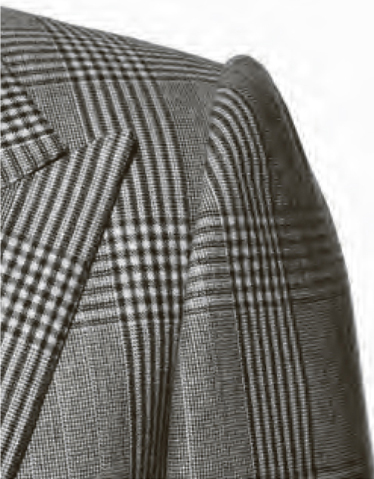The chassis of the suit, that from which everything hangs, that if not correct nothing will be, the coat shoulder. The entire look of a coat is dictated from the form of the shoulder, and is one of the few things that can’t be effectively altered after purchase.
There are many different styles and variations of shoulders on a man’s jacket that lie outside the dictates of fashion, and the whims of trend. They instead derive their form from the continents and schools of tailoring that created and refined them. While there is no correct shoulder form, certain types suit different shapes and looks much better, for example when ordering a jacket that you want to be deconstructed, casual and almost preppy you would be wise to eschew the English shoulder and maybe even the Roped in favour of the Natural for the best possible result. This article will try and explain the difference between each.
ENGLISH

Possibly what most people would call a “normal” shoulder (especially in the English speaking world). The easiest way to spot this is to look for the nearly 90 degree angle at the sleeve head with minimal shoulder roll. The will be enough padding to absorb the shape of the shoulder and draw a diagonal line from the neck to the shoulder, but no more. The english shoulder is often not much padded than many of its counter parts, but just enough to create this line. The classic English style (in every aspect) is the Huntsman shape, which is what is featured in the image. It is designed to give a very shape crisp finish, enabling the waist to be cinched neatly, and provide a slimming appearance. It does to tend to be very formal compared to other styles, with it’s sharp lines and cinched waist.
ITALIAN
There are several variants on the Italian shoulder, depending what school the tailor is trained in. The stereotypical version is commonly known as a roped shoulder, or sometimes a Roman shoulder.

As you can clearly see the reason it is called roped, is the appearance of the exaggerated lip at the join of the shoulder and the sleeve. This highlights the finish of the shoulder creating the appearance of broadness, hence slimness at the waist. It also helps keep the fullness in the sleeve.
The other major variant of the Italian style is the Spalla Camicia (literally “shirt shoulder”
As you can see, the extra ease is inserted into the sleeve head with small pleats known as shirring. This is often referred to as the Neapolitan shoulder, as it originated in Naples. This creates a slightly more relaxed line, and moves more towards the natural shoulder line.
This great image shows the differences that the two predominant Italian shoulder styles have on the appearance of the garment. The roped shoulder announces the shoulder more prominently while the Spalla Camicia is more relaxed in look. The main concept of Italian tailoring is the the shoulder should have as little padding as possible and is epitomized by Brioni who only use canvas construction to create their beautiful suits.
NATURAL
Even further on the relaxed scale is the natural shoulder, sometimes known as the American shoulder.
This was orginally created in rebellion against the classic English styles by early American tailors, and as such is one of the key ingredients to the preppy style. This look is embraced by international clothiers such as Brooks Brothers. As a rule this style is better suited to relaxed fits, but is currently very much in vogue as a slim fit style. The basic premise is that there is absolutely no construction or padding in the shoulder at all and the garment literally hangs off the wearer’s body.
WHICH ONE?
The choice of what style to choose is somewhat daunting but also quite simple too.
First, you don’t have to just have one, I have suits and sports coats in all styles and use them as a style detail. A basic guideline is to understand what each style does for your shape, the less structure and line, the less emphasis on your shoulder and more on your waistline, so pear shaped clients should opt for more structure, while muscular men definitely benefit from less padding.

For those interested I have included this image showing the differences in the actual construction concepts for each too.



